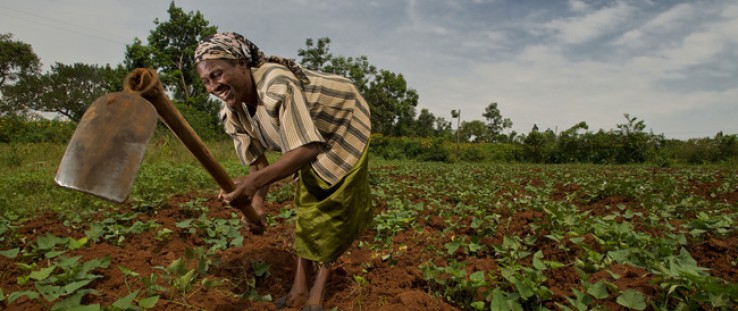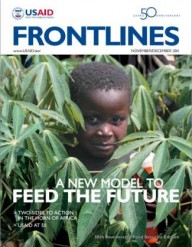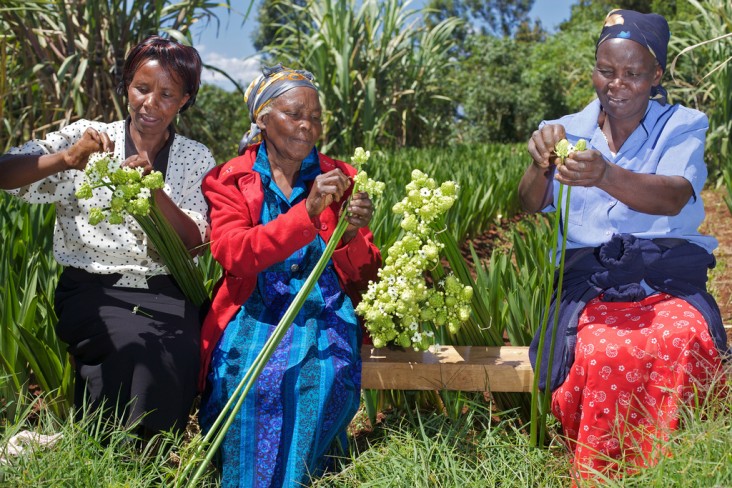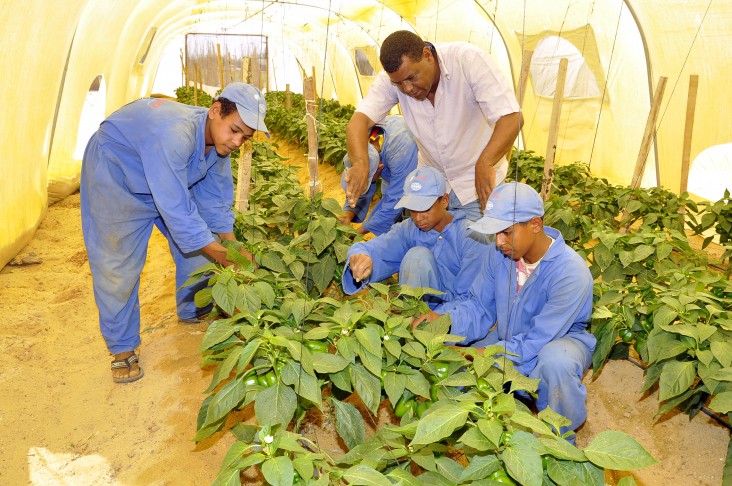 USAID/Kenya helps small-scale farmers and business people get the skills, technology, loans, and market connections they need to succeed.
CREDIT: NEIL THOMAS, USAID
USAID/Kenya helps small-scale farmers and business people get the skills, technology, loans, and market connections they need to succeed.
CREDIT: NEIL THOMAS, USAID
 USAID/Kenya helps small-scale farmers and business people get the skills, technology, loans, and market connections they need to succeed.
CREDIT: NEIL THOMAS, USAID
USAID/Kenya helps small-scale farmers and business people get the skills, technology, loans, and market connections they need to succeed.
CREDIT: NEIL THOMAS, USAID
Over its first half century, USAID has been at the forefront of agricultural development as a driver of economic transformation and growth. Operating in more than 100 countries spread out around the world, the Agency has tailored its work in agriculture to fit the needs of specific countries, and has done some remarkable things.
Though the list of achievements is long, USAID has traditionally focused more on “doing” development than documenting its successes in concrete and specific terms or telling its story. In the same vein, the decentralized nature of the Agency has contributed to the difficulty of telling this story. “Many of USAID’s achievements in agriculture have been undocumented, unrecognized, or simply forgotten,” says Emmy B. Simmons, former USAID assistant administrator of the Bureau for Economic Growth, Agriculture and Trade.
To ensure the Agency is learning from the past, including mistakes, and building on successes, USAID’s Legacy in Agricultural Development (ALAD) was launched at the end of 2010. Through a nine-month process of interviews, document searches, and peer reviews, the project has identified major themes and achievements that reflect broad successes, as well as lessons learned over the past 50 years.
Having documented key USAID achievements in agricultural development—through a report and information sheets—ALAD is ready to tell this story to the American people. This fall, the products will be accessible at www.agrilinks.kdid.org.
After the global food price crisis of 2007-2008 increased the number of hungry people around the planet by an estimated 75 million, governments, donor agencies, and research networks around the world started showing new interest in agriculture’s powerful contributions to expanding economic growth and reducing poverty. Agriculture is making a comeback in the Agency and mission programming.
While the ALAD project helps to tell USAID and the larger global development community where the Agency has been, it can also help point the way to where it is going through new efforts like Feed the Future, the U.S. Government’s global food security initiative.
Egyptian Veggies
One of ALAD’s success stories focuses around Egypt’s fruit and vegetable trade. For decades, Egypt’s horticulture exports idled in neutral, averaging $150 million per year between 1975 and 2002. But by 2008, the value of Egypt’s fruit and vegetable exports increased more than sixfold—to $1 billion per year.
Accomplishments in Agriculture
During its first 50 years, USAID has: helped millions of households secure access to land and other resources;
- mobilized science and technology (both conventional and biotech approaches) that tripled yields for the basic food crops;
- built dozens of agricultural education institutions overseas and trained thousands of foreign students in the United States, creating lasting agricultural capacity in developing countries;
- invested in job-creating small and medium rural agricultural enterprises and value chains;
- expanded global and regional agricultural trade opportunities and helped agricultural exporters comply with food quality and safety standards;
- integrated environmental and natural resources management into agricultural practices and livelihoods.
The increase was made possible in part through decades of USAID technical support to the country. The Agency’s contributions included helping to establish the Horticultural Export Improvement Association and the perishable terminal at Cairo International Airport, strengthening agricultural research capability, promoting policy reform, and enhancing the market for business development services.
Today, Egypt is the third largest exporter of fresh fruits and vegetables on the African continent, supplying 14 percent of the total fruit and vegetable exports.
This is not to say that USAID’s agriculture work in Egypt is complete. Agribusiness and food production remain a key aspect of Egypt’s economy and a means for broadening prosperity. Working with 117 agricultural technical schools with more than 160,000 students, USAID, its implementing partners, the Midwest University Consortium for International Activities (MUCIA), and the Government of Egypt are building the skills demanded by Egypt’s commercial farming sector.
“Egypt is experiencing unprecedented change,” says USAID/Egypt Mission Director Walter North. “Our work is preparing Egypt’s youth to build a world-class commercial farming sector in some of the poorest, most remote parts of the country.”
Country-Owned, Country-Led
President Barack Obama’s Feed the Future initiative, led by USAID, seeks to help developing countries achieve the kind of agricultural success accomplished in Egypt and elsewhere through country-owned, country-led strategies.
For example, Kenya—a regional leader in both dairy and horticulture—is a Feed the Future focus country and is an example of how the Agency can use lessons learned from Egypt for the benefit of other countries. Feed the Future’s goal for Kenya is bold: to help 3 million Kenyans exit poverty by 2015—550,000 of whom will benefit from USAID’s contribution.
<>Kenya’s agriculture sector shows substantial potential for growth, and, therefore, a path out of hunger and poverty for millions who live there. With the largest dairy herd in East and Southern Africa and a relatively well-developed industry, Kenya is poised to meet the growing local demand for milk as well as target the regional market.
Kenya’s horticulture industry is also an established leader among African suppliers of fresh produce to Europe. Known for their competitiveness, Kenya’s producers—including women, a particular focus for Feed the Future programming—are in an excellent position to capture the emerging global demand for new value-added products as well as the local and regional fresh market valued at more than $2 billion.
Work in these sectors is important because both horticulture and dairy will be critical commodities in smallholders’ diversification out of maize in Kenya—a crop that is grown by 98 percent of the rural farm households and makes up a large share of households’ crop income. Like what was done in Egypt, USAID, through Feed the Future, will help the initiative’s focus countries increase their agricultural productivity and profitability to achieve the same kinds of agriculture and trade gains that will help rural households increase their income, nutrition, and food security.
It is often said that USAID works to create the conditions for countries to graduate from aid to trade. That’s a major goal of Feed the Future as the U.S. Government works to alleviate global hunger and poverty. Rob Bertram, director of the Agricultural Research and Policy Office in USAID’s Bureau for Food Security, sums it up: “The ALAD project, in its review of 50 years of USAID progress in agriculture thus far, helps us to appreciate that journey and celebrate our many successes along the way.”
More about ALAD:
The first phase of the ALAD work, with a retrospective on USAID’s achievements and lessons learned culminating in a report and information sheets, is scheduled to wrap up in fall 2011. But telling USAID’s story remains a work in progress. Anyone interested in providing documentation of what USAID has accomplished in the past five decades should contact Phil Steffen and Anne Williams, ALAD activity co-managers, at psteffen@usaid.gov and awilliams@usaid.gov.











Comment
Make a general inquiry or suggest an improvement.